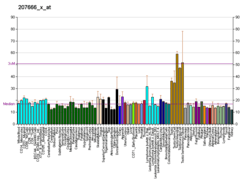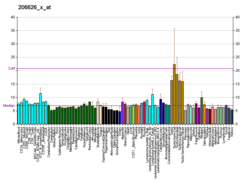References
- 1 2 3 GRCh38: Ensembl release 89: ENSG00000241476 - Ensembl, May 2017
- ↑ "Human PubMed Reference:".
- ↑ Tureci O, Sahin U, Schobert I, Koslowski M, Scmitt H, Schild HJ, Stenner F, Seitz G, Rammensee HG, Pfreundschuh M (Nov 1996). "The SSX-2 gene, which is involved in the t(X;18) translocation of synovial sarcomas, codes for the human tumor antigen HOM-MEL-40". Cancer Res. 56 (20): 4766–72. PMID 8840996.
- 1 2 "Entrez Gene: SSX2 synovial sarcoma, X breakpoint 2".
Further reading
- Wu LQ, Lu Y, Wang XF, et al. (2006). "Expression of cancer-testis antigen (CTA) in tumor tissues and peripheral blood of Chinese patients with hepatocellular carcinoma". Life Sci. 79 (8): 744–8. doi:10.1016/j.lfs.2006.02.024. PMID 16546222.
- Mehrle A, Rosenfelder H, Schupp I, et al. (2006). "The LIFEdb database in 2006". Nucleic Acids Res. 34 (Database issue): D415–8. doi:10.1093/nar/gkj139. PMC 1347501. PMID 16381901.
- Rual JF, Venkatesan K, Hao T, et al. (2005). "Towards a proteome-scale map of the human protein-protein interaction network". Nature. 437 (7062): 1173–8. doi:10.1038/nature04209. PMID 16189514.
- Fernebro J, Francis P, Edén P, et al. (2006). "Gene expression profiles relate to SS18/SSX fusion type in synovial sarcoma". Int. J. Cancer. 118 (5): 1165–72. doi:10.1002/ijc.21475. PMID 16152617.
- Ross MT, Grafham DV, Coffey AJ, et al. (2005). "The DNA sequence of the human X chromosome". Nature. 434 (7031): 325–37. doi:10.1038/nature03440. PMC 2665286. PMID 15772651.
- Tvrdík D, Povýsil C, Svatosová J, Dundr P (2005). "Molecular diagnosis of synovial sarcoma: RT-PCR detection of SYT-SSX1/2 fusion transcripts in paraffin-embedded tissue". Med. Sci. Monit. 11 (3): MT1–7. PMID 15735574.
- Ayyoub M, Merlo A, Hesdorffer CS, et al. (2005). "Distinct but overlapping T helper epitopes in the 37-58 region of SSX-2". Clin. Immunol. 114 (1): 70–8. doi:10.1016/j.clim.2004.08.014. PMID 15596411.
- Wiemann S, Arlt D, Huber W, et al. (2004). "From ORFeome to biology: a functional genomics pipeline". Genome Res. 14 (10B): 2136–44. doi:10.1101/gr.2576704. PMC 528930. PMID 15489336.
- Gerhard DS, Wagner L, Feingold EA, et al. (2004). "The status, quality, and expansion of the NIH full-length cDNA project: the Mammalian Gene Collection (MGC)". Genome Res. 14 (10B): 2121–7. doi:10.1101/gr.2596504. PMC 528928. PMID 15489334.
- Strausberg RL, Feingold EA, Grouse LH, et al. (2003). "Generation and initial analysis of more than 15,000 full-length human and mouse cDNA sequences". Proc. Natl. Acad. Sci. U.S.A. 99 (26): 16899–903. doi:10.1073/pnas.242603899. PMC 139241. PMID 12477932.
- Güre AO, Wei IJ, Old LJ, Chen YT (2002). "The SSX gene family: characterization of 9 complete genes". Int. J. Cancer. 101 (5): 448–53. doi:10.1002/ijc.10634. PMID 12216073.
- Yang K, Lui WO, Xie Y, et al. (2002). "Co-existence of SYT-SSX1 and SYT-SSX2 fusions in synovial sarcomas". Oncogene. 21 (26): 4181–90. doi:10.1038/sj.onc.1205569. PMID 12037676.
- de Bruijn DR, dos Santos NR, Kater-Baats E, et al. (2002). "The cancer-related protein SSX2 interacts with the human homologue of a Ras-like GTPase interactor, RAB3IP, and a novel nuclear protein, SSX2IP". Genes Chromosomes Cancer. 34 (3): 285–98. doi:10.1002/gcc.10073. PMID 12007189.
- Brodin B, Haslam K, Yang K, et al. (2001). "Cloning and characterization of spliced fusion transcript variants of synovial sarcoma: SYT/SSX4, SYT/SSX4v, and SYT/SSX2v. Possible regulatory role of the fusion gene product in wild type SYT expression". Gene. 268 (1–2): 173–82. doi:10.1016/S0378-1119(01)00412-7. PMID 11368913.
- Simpson JC, Wellenreuther R, Poustka A, et al. (2001). "Systematic subcellular localization of novel proteins identified by large-scale cDNA sequencing". EMBO Rep. 1 (3): 287–92. doi:10.1093/embo-reports/kvd058. PMC 1083732. PMID 11256614.
- Hartley JL, Temple GF, Brasch MA (2001). "DNA cloning using in vitro site-specific recombination". Genome Res. 10 (11): 1788–95. doi:10.1101/gr.143000. PMC 310948. PMID 11076863.
- dos Santos NR, Torensma R, de Vries TJ, et al. (2000). "Heterogeneous expression of the SSX cancer/testis antigens in human melanoma lesions and cell lines". Cancer Res. 60 (6): 1654–62. PMID 10749136.
- dos Santos NR, de Bruijn DR, Balemans M, et al. (1998). "Nuclear localization of SYT, SSX and the synovial sarcoma-associated SYT-SSX fusion proteins". Hum. Mol. Genet. 6 (9): 1549–58. doi:10.1093/hmg/6.9.1549. PMID 9285793.
- Shipley JM, Clark J, Crew AJ, et al. (1994). "The t(X;18)(p11.2;q11.2) translocation found in human synovial sarcomas involves two distinct loci on the X chromosome". Oncogene. 9 (5): 1447–53. PMID 8152806.




